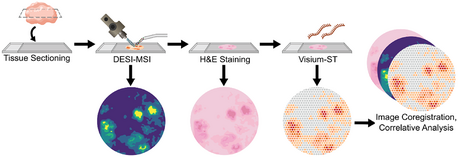Integrating Ambient Ionization Mass Spectrometry Imaging and Spatial Transcriptomics on the Same Cancer Tissues to Identify RNA–Metabolite Correlations
Graphical Abstract
Innovations in spatial omics have advanced disease research, but spatial transcriptomics (ST) and spatial metabolomics remain separate. We present a novel method integrating DESI-MSI spatial metabolomics and Visium-ST on the same tissue sections while preserving RNA quality and data integrity. Applied to breast and lung cancer tissue, this approach reveals new metabolite-transcript correlations in cancer regions, enhancing spatial multi-omics discoveries.
Abstract
Innovations in spatial omics technologies applied to human tissues have led to breakthrough discoveries in various diseases, including cancer. Two of these approaches—spatial transcriptomics and spatial metabolomics—have blossomed independently, fueled by technologies such as spatial transcriptomics (ST) and mass spectrometry imaging (MSI). Although powerful, these technologies only offer insights into the spatial distributions of restricted classes of molecules and have not yet been integrated to provide more holistic insights into biological questions. These techniques can be performed on adjacent serial sections from the same sample, but section-to-section variability can convolute data integration. We present a novel method combining desorption electrospray ionization mass spectrometry imaging (DESI-MSI) spatial metabolomics and Visium spatial transcriptomics on the same tissue sections. We show that RNA quality is maintained after performing DESI-MSI on a tissue under ambient conditions and that ST data is unperturbed following DESI-MSI. We demonstrate this workflow on human breast and lung cancer tissues and identify novel correlations between metabolites and mRNA transcripts in cancer-specific tissue regions.
Conflict of Interests
L.S.E. is an inventor in patents related to DESI-MS imaging technology owned by Purdue Research Foundation that were licensed to Waters Corporation and receives royalties from sales of the systems. W.Z., T.T., N.V., and N.H.P. are employees at Aspect Analytics NV. N.V. is a shareholder of Aspect Analytics NV.
Open Research
Data Availability Statement
The data that support the findings of this study are openly available in Dataverse at https://doi.org/10.7910/DVN/GZFCWC, reference number 107910.





